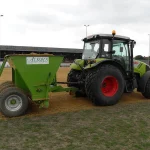No-dig gardening is a simple and sustainable approach to growing a healthy garden. You just layer compost and organic matter onto the soil, without digging, which will help improve soil structure, support biodiversity and reduce weeds.
Are you looking to improve your tired soil or ready to create a new bed? Our guide will take you through how to build your no-dig garden with quality compost, organic materials and soil conditioner.
What Is No-Dig Gardening?
No-dig gardening won’t disturb your soil. With no digging required all you need to do is layer compost or rotted manure onto the soil. Doing this will allow worms and microbes to break it down naturally leaving your soil more healthy, more fertile, and with less weeds.
Looking after your soil’s structure will mean your plants grow stronger more easily. It’s perfect for vegetable beds, raised beds, or giving overgrown areas a new lease of life. The no-dig method is one that is widely recognised by expert gardeners for its long-lasting benefits and easy approach.
Benefits of a No-Dig Garden
Choosing the no-dig method will bring you a wide range of benefits for not just your plants but also you! From small gardens to larger allotments, this approach will make soil care so much simpler and more effective.
1. Healthier Soil Structure
Leaving the soil undisturbed helps maintain its natural structure. Microorganisms, fungi, and worms are left intact, allowing them to do their job of breaking down organic matter and feeding your plants naturally.
2. Fewer Weeds
By avoiding digging, you reduce the number of dormant weed seeds brought to the surface. Covering the soil with compost or mulch also suppresses weeds, making them easier to manage long term.
3. Better Moisture Retention
A well-mulched no-dig bed helps retain moisture, reducing the need for frequent watering. This is especially useful in dry spells or when working on sandy soils.
4. Saves Time and Effort
Without the need to dig, till, or double-dig your beds, setup and maintenance are much easier. This method is ideal for those with limited time or physical limitations.
5. Improves Soil Life and Fertility
Layering compost and organic matter feeds the soil from the top down, just like in nature. Over time, your beds become richer and more productive, with less need for added fertilisers.
What You’ll Need
Starting a no-dig garden doesn’t require specialist tools or equipment, but choosing the right materials is key to success. Here’s what you’ll need to get started:
1. Compost
High-quality compost is the foundation of a no-dig bed. You’ll need enough to create a layer around 10 to 15cm deep. Well-rotted green waste compost or peat-free compost works well.
2. Soil Conditioner (Optional)
For very poor or compacted ground, adding a soil conditioner beneath the compost layer can help improve drainage and encourage better root growth over time.
3. Well-Rotted Manure
Manure can be used as part of your compost layer or as an additional top-up in autumn or winter. It adds nutrients and encourages microbial activity in the soil.
4. Mulch (Optional)
Applying a mulch layer, such as bark or composted wood chips, can help retain moisture and protect the soil surface.
5. A Defined Bed or Border
Raised beds, timber edging, or clearly marked plots help contain your compost and make maintenance easier. These also support tidiness and structure in small or shared spaces.
Step-by-Step: How to Start a No-Dig Garden
Starting a no-dig garden is straightforward and rewarding. Follow these simple steps to build healthy, productive beds with minimal effort.
1. Choose Your Site
Pick a spot that receives plenty of sunlight and has good drainage. Whether it’s an overgrown patch, a grassy area, or an existing bed, no-dig works on most surfaces.
2. Add a Thick Layer of Compost
Spread compost across the entire area, aiming for a depth of 10 to 15cm. This becomes your growing layer. You can use a single type of compost or mix it with soil conditioner or well-rotted manure for extra nutrients.
Not sure how much compost you need? Check out our compost calculator here.
4. Water the Bed
Give the bed a good soak after laying your compost. This encourages microbial activity and helps settle the layers.
5. Plant Directly into the Compost
Once the surface is prepared, you can plant straight into the compost. Start with seedlings or plug plants if you’re new to this method, as they establish quickly.
6. Maintain with Mulch
Top up with compost or mulch once or twice a year to keep weeds down and feed the soil. Avoid walking on the beds to maintain structure.
This method improves over time. Each season, your soil becomes richer and more workable, with fewer weeds and better plant health!
Key Take Aways
So there you have it, no-dig gardening really is that simple. It’s an easy and sustainable way to grow happier and healthier plants with little effort. Layering compost and organic matter instead of disturbing the soil is the best way to create a truly thriving ecosystem that improves over time.
At Alsoils, we supply high-quality compost, soil conditioner, and well-rotted manure by loose load or bulk delivery, making it easy to start or expand your no-dig garden. If you have any questions about how much compost you need or which products are right for your space, get in touch with our expert team. Or why not browse our full range to take the next step toward building a healthier, low-maintenance garden.





